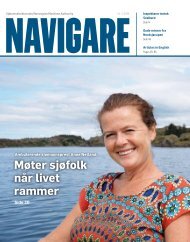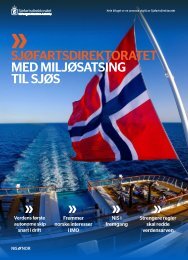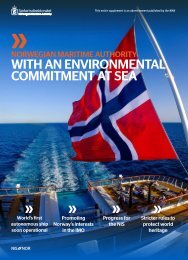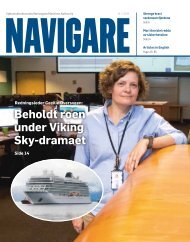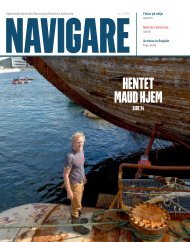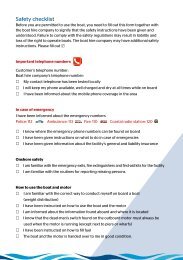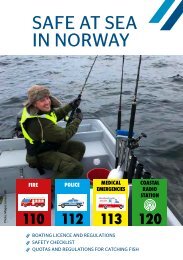You also want an ePaper? Increase the reach of your titles
YUMPU automatically turns print PDFs into web optimized ePapers that Google loves.
Editorial<br />
english translation from page 4<br />
Together we are great<br />
At the beginning of February, I attended<br />
the annual maritime «Haugesund<br />
Conference» together with a great number<br />
of people. This is an important arena for<br />
maritime questions and general conditions,<br />
and it is always good to be there as a<br />
participant or a speaker.<br />
This year, it was especially enjoyable as<br />
several of the speakers mentioned the role<br />
the Norwegian Maritime Authority has<br />
played in the work to introduce new<br />
technology. This praise will of course be<br />
conveyed to my colleagues in the NMA,<br />
who every day are in dialogue with<br />
various customers with different needs<br />
– some with questions concerning older<br />
vessels, others with more complicated<br />
problems when new technology is<br />
introduced. At the same time, it is<br />
important to emphasise that even though<br />
we appreciate the praise, it is the<br />
cooperation between the public authorities<br />
and the Norwegian private maritime<br />
sector that makes this an extra good story<br />
to tell.<br />
Former prime minister, Ms. Gro Harlem<br />
Brundtland, once said that it is typically<br />
Norwegian to be good. We may not<br />
always be quick to point to the ones who<br />
do good, but the Norwegian Maritime<br />
Authority would like to praise all of our<br />
customers who dare venture into new<br />
technology. This is demanding both on<br />
them and on us, but feedback now<br />
suggests that we have a good cooperation.<br />
This means a lot for Norway as a nation,<br />
especially since new environmentally<br />
friendly technology will have a great<br />
impact when the shipping industry works<br />
to reach their goal of 50% reduction in<br />
emission within the year 2050.<br />
There is a long list of projects within the<br />
maritime industry that has put Norwegian<br />
operators on the world map. In the year<br />
2000, Norway and the world had its first<br />
LNG-operated car ferry when the «MF<br />
Lutra» was put into operation by the<br />
Lars Alvestad<br />
Acting Director General of Shipping<br />
and Navigation<br />
Møre og Romsdal Fylkesbåtar (MRF).<br />
This made way for a number of even<br />
more environmentally friendly ferries over<br />
the years to come. Eidesvik’s vessel<br />
«Viking Energy» was the first one to use<br />
LNG on a supply vessel, and in 2<strong>01</strong>6,<br />
the same vessel was also the first ship to<br />
get permission to use batteries as<br />
«spinning reserve» during DP-operations.<br />
In 2<strong>01</strong>5 another international sensation<br />
from Norway was introduced; the first<br />
all-electric car-ferry “MF Ampere”<br />
started crossing the fjord Sognefjorden<br />
on commission for Norled. Experience<br />
from this project are so good that the<br />
Norwegian Directorate for Public Roads<br />
has signalled that within 2022, there will<br />
be 70 all-electric ferries running in<br />
Norway. Environmental requirements<br />
stated in tenders, the cooperation between<br />
public authorities and innovative<br />
environments and shipowner that are<br />
willing to back this, will enable Norway<br />
to lead the work on new technology.<br />
Also within autonomy, we are ahead<br />
now that “Yara Birkeland”, the world’s<br />
first autonomous container vessel, is<br />
under construction. At the Haugesund<br />
Conference, the shipping company<br />
Hagland also presented plans for using<br />
hybrid technology on its domestic fleet.<br />
In this connection, we are happy that the<br />
response from customers, both private<br />
and public, is that the Norwegian<br />
Maritime Authority is capable of both<br />
thinking about security and at the same<br />
time give room for the development of<br />
new technology.<br />
However, it does not stop there! Both<br />
battery and LNG are now established<br />
as new energy forms, although battery is<br />
still at the starting line. Innovation is still<br />
happening. In January, me and several<br />
colleagues were present when the<br />
Norwegian Directorate for Public Roads<br />
signed a development contract for the<br />
world’s first hydrogen-powered car ferry.<br />
The shipping company Norled will use<br />
this ferry at the Hjelmeland crossing in<br />
Ryfylke, in the inner parts of the fjord<br />
Boknafjord. We do not yet know the<br />
extent of this technology, but there is no<br />
doubt that it may mean a lot when we<br />
start using more environmentally friendly<br />
energy on longer ferry crossings.<br />
These are both exciting and demanding<br />
times for the Norwegian Maritime<br />
Authority. We find that customers require<br />
more of us and our performance, and we<br />
are prepared to handle that. In this<br />
respect, it has been a great help that we<br />
were given the opportunity to increase<br />
our workforce through the revised<br />
national budget last year. We will do our<br />
utmost so that Norway may continue to<br />
be leading developer of new environmentally<br />
friendly solutions for the<br />
shipping industry, but at the same time<br />
there must be no doubt that no matter<br />
what, safety comes first!<br />
<strong>Navigare</strong> 1 - 2<strong>01</strong>9 | 55










